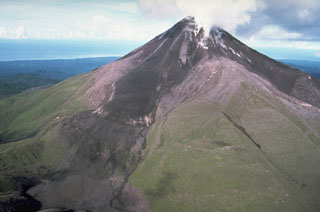Report on Bagana (Papua New Guinea) — March 1988
Scientific Event Alert Network Bulletin, vol. 13, no. 3 (March 1988)
Managing Editor: Lindsay McClelland.
Bagana (Papua New Guinea) Summit glow above new dome
Please cite this report as:
Global Volcanism Program, 1988. Report on Bagana (Papua New Guinea) (McClelland, L., ed.). Scientific Event Alert Network Bulletin, 13:3. Smithsonian Institution. https://doi.org/10.5479/si.GVP.SEAN198803-255020
Bagana
Papua New Guinea
6.137°S, 155.196°E; summit elev. 1855 m
All times are local (unless otherwise noted)
Low-level activity continued through March, with continuous production of moderate to strong white vapour from the summit area. Summit glow was noted on several nights during the month. Seismicity was at a low level, with only 1-10 events recorded/day.
Geological Summary. Bagana volcano, in a remote portion of central Bougainville Island, is frequently active. This massive symmetrical cone was largely constructed by an accumulation of viscous andesitic lava flows. The entire edifice could have been constructed in about 300 years at its present rate of lava production. Eruptive activity is characterized by non-explosive effusion of viscous lava that maintains a small lava dome in the summit crater, although occasional explosive activity produces pyroclastic flows. Lava flows with tongue-shaped lobes up to 50 m thick and prominent levees descend the flanks on all sides.
Information Contacts: P. de Saint-Ours and C. McKee, RVO.

